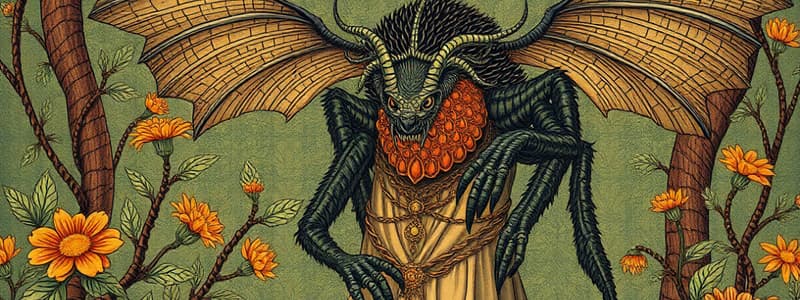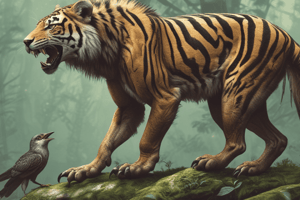Podcast
Questions and Answers
What is the primary goal of modeling predator-prey interactions?
What is the primary goal of modeling predator-prey interactions?
- To eliminate predators.
- To create artificial habitats.
- To predict outcomes or explain patterns. (correct)
- To demonstrate a food chain.
Empirical evidence is concerned with observation and experience rather than theory.
Empirical evidence is concerned with observation and experience rather than theory.
True (A)
What indicates top-down control in an ecosystem according to the studies on spiders and lizards?
What indicates top-down control in an ecosystem according to the studies on spiders and lizards?
The presence of predators decreases the number of prey.
Theoretical modeling in ecology primarily involves __________ methods.
Theoretical modeling in ecology primarily involves __________ methods.
Match the following terms with their definitions:
Match the following terms with their definitions:
What research method was used when spiders were introduced to islands with and without lizards?
What research method was used when spiders were introduced to islands with and without lizards?
The study by Schoener and Toft observed that islands with predators had more orb spiders than those without.
The study by Schoener and Toft observed that islands with predators had more orb spiders than those without.
What evidence supported the concept of top-down control in the study of spiders and lizards?
What evidence supported the concept of top-down control in the study of spiders and lizards?
What is one of the primary goals of modeling predator-prey interactions?
What is one of the primary goals of modeling predator-prey interactions?
Empirical evidence in ecology is based solely on theoretical assumptions.
Empirical evidence in ecology is based solely on theoretical assumptions.
What does top-down control refer to in population regulation?
What does top-down control refer to in population regulation?
The study conducted by Schoener and Toft suggested that islands without lizards have __________ orb spiders.
The study conducted by Schoener and Toft suggested that islands without lizards have __________ orb spiders.
Match the following terms with their descriptions:
Match the following terms with their descriptions:
In the experimental manipulation involving spiders, what was the key variable being tested?
In the experimental manipulation involving spiders, what was the key variable being tested?
Natural experiments can provide empirical support for theoretical models.
Natural experiments can provide empirical support for theoretical models.
What was the outcome of the observation regarding orb spiders on islands with lizards?
What was the outcome of the observation regarding orb spiders on islands with lizards?
The study by Schoener and Toft used __________ manipulation to observe spider populations.
The study by Schoener and Toft used __________ manipulation to observe spider populations.
Which of the following best describes the relationship between spiders and lizards as found in the study?
Which of the following best describes the relationship between spiders and lizards as found in the study?
Flashcards
Predator-Prey Interactions
Predator-Prey Interactions
The relationship between predators and their prey, often modeled mathematically to predict outcomes or explain patterns in population sizes.
Bottom-up Control
Bottom-up Control
Population regulation where the abundance of prey limits the abundance of predators.
Top-down Control
Top-down Control
Population regulation where the abundance of predators limits the abundance of prey.
Mathematical Modeling
Mathematical Modeling
Signup and view all the flashcards
Empirical Support
Empirical Support
Signup and view all the flashcards
Theoretical Ecology
Theoretical Ecology
Signup and view all the flashcards
Natural Experiment
Natural Experiment
Signup and view all the flashcards
Experimental Manipulation
Experimental Manipulation
Signup and view all the flashcards
Predator-Prey Interactions
Predator-Prey Interactions
Signup and view all the flashcards
Population Regulation
Population Regulation
Signup and view all the flashcards
Bottom-up Control
Bottom-up Control
Signup and view all the flashcards
Top-down Control
Top-down Control
Signup and view all the flashcards
Mathematical Modeling
Mathematical Modeling
Signup and view all the flashcards
Empirical Support
Empirical Support
Signup and view all the flashcards
Theoretical Ecology
Theoretical Ecology
Signup and view all the flashcards
Natural Experiment
Natural Experiment
Signup and view all the flashcards
Experimental Manipulation
Experimental Manipulation
Signup and view all the flashcards
Focal Population
Focal Population
Signup and view all the flashcards




